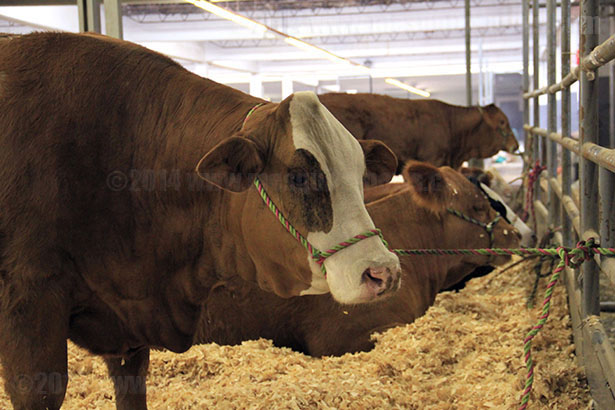
By Rebecca Salinas
In the cattle barn at the San Antonio Stock Show and Rodeo Feb. 7, ranchers and farmers huddled together to stay warm from the cold, wet conditions outside.
Although Texans are seeing more rainy days, ranchers and farmers are still recovering from the drought that struck the state a few years. ago.
Among the cows and cowboy boots were Southside Future Farmers of America members Daniel Dominguez, 12, and Justin Huron, 16.
They agreed that if water were to run out in Texas, their livelihood would change. They would be forced to give up their Beefmaster cows because there would be no water to hydrate them, or grass to eat.
Dominguez said it would be hard to get rid of his cow, but he also knows water is the most important thing for his Beefmaster, Danielle.
The issue of water scarcity in Texas has been a legislative issue even prior to the approval of Proposition 6, a legislative response to the state’s devastating 2011 drought. Prop 6 is a constitutional amendment that established a State Water Implementation Fund for Texas to support projects to help conserve water.

Sixty-five percent of this state’s water supply is used for agriculture, which includes everything from irrigation to consumption, state Rep. Lyle Larson, R-District 122, stated at the “Planning San Antonio’s Water Future” town hall meeting Feb. 6.
Hoping to be a future farmer and rancher, Dominguez said it is important to conserve water now, especially since he plans on staying in South Texas.
In terms of planning for the future, younger ranchers and farmers are not aware of the effects.
Michaela Willms, FFA member at Sandra Day O’Connor High School, and Erin Kuykedall, FFA member at Bandera High School, said their teachers have not addressed the issue, even when climatologists predict 10-15 more years of dry conditions.
On the other hand, experienced ranchers know the consequences of water scarcity.
Madison Mello, a ranch hand at Lassere Club Calves in Natalia, said most of the water used goes to fill the cows’ water troughs.
Mellow said the water trough at her grandfather’s ranch holds 2,000 gallons of water, and is constantly on a float-controlled valve. Her grandfather owns 30 cows and 15 calves. Each can drink anywhere from 15-25 gallons.
She and her grandfather use water for irrigation to grow Bermuda, Alfalfa and Coastal hays. On one acre, 4,000 gallons of water are used a day for irrigation.
Mellow used to get water from Medina Lake, but had to stop once the lake’s water levels dropped. Medina Lake is 3.4 percent full, 88 feet below average.
Water shortage in Medina Lake is one result of the drought that devastated farms and ranches throughout Texas in 2011.
Across the barn, Mark Brown, owner of Brown Longhorns, tended to his longhorns with country music blaring.
Brown, a ranch owner in Leon Springs, said his ranch still has not recovered from the drought, and predicts it will take 10 years to recover. He reduced the number of cattle from 100 to 20 in the last eight years, and still plans to sell a few more.

Adding to Brown’s response, Willms said the cattle “smell a bit” because they had to cut down on the amount of baths they are given.
Joe B. Rodriguez, owner of La Morra Cattle Company in Floresville, said his ranch is “years away from full recovery” and conserves water by irrigating less.
He said when ranchers do not irrigate, they depend on the weather to supply the rain, a term ranchers and farmers refer to as “dry farming.” The weather is hard to predict, he said, so it’s like they are taking a gamble with planting.
“Whenever it rains, everybody is a great rancher,” Rodriguez said. “Everybody wants to be a rancher when it is green.”
He added respectable ranchers and farmers can do their job without rain.
Ranchers agreed using as little water as possible on a daily basis would have a large impact.
Brown said people need to be considerate and “quit watering concrete.” Living in Leon Springs, Brown sees a lot of wasted water from golf courses and the Dominions.
“I see water running down the street,” he said.
It’s the “little things” that matter, Rodriguez said, like turning off the water while brushing your teeth and conserving water while showering.






